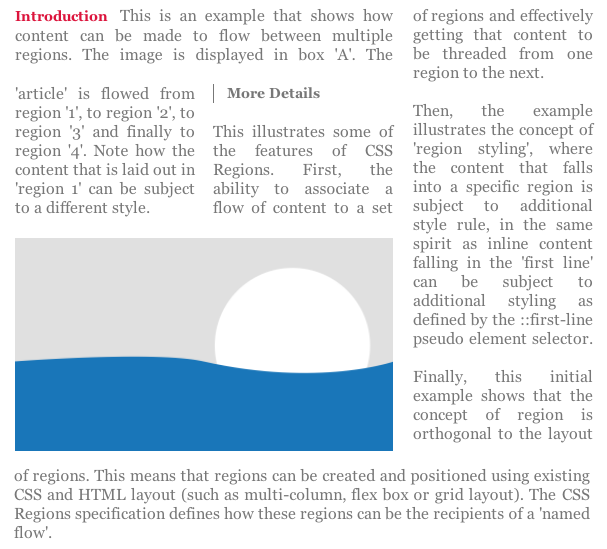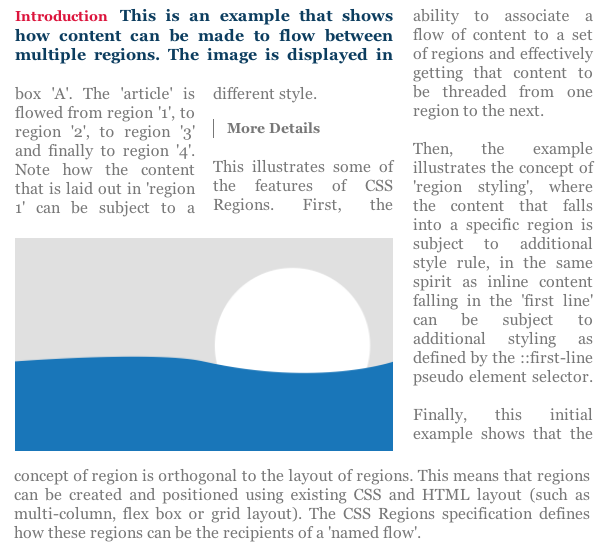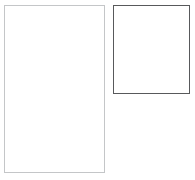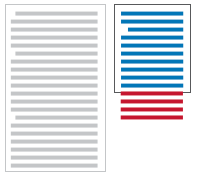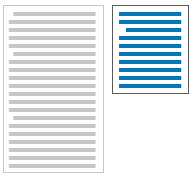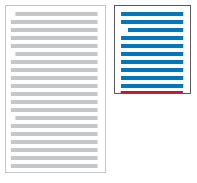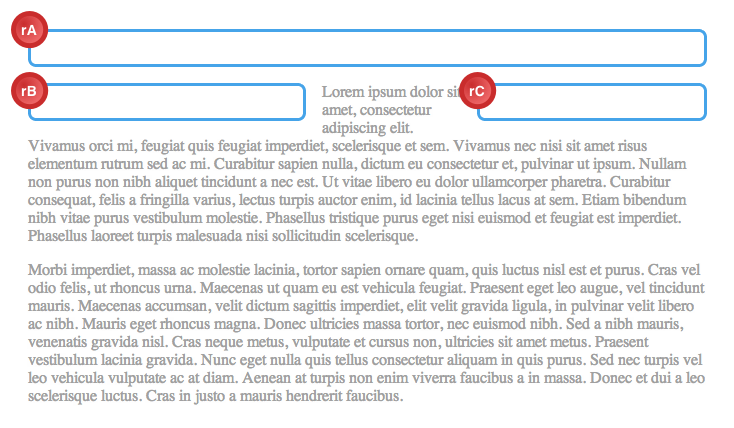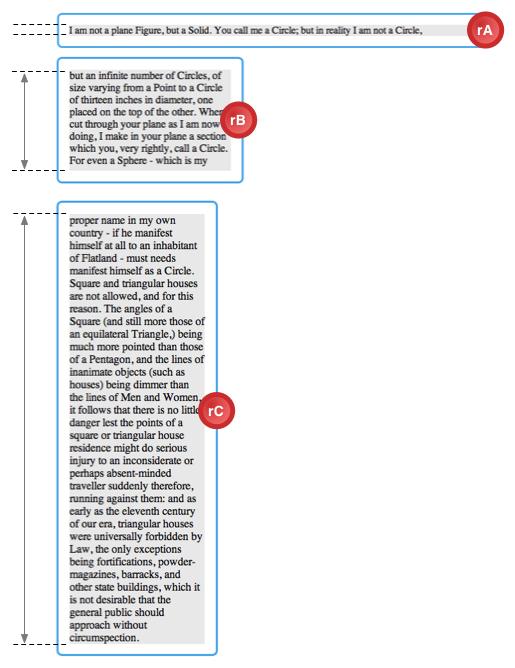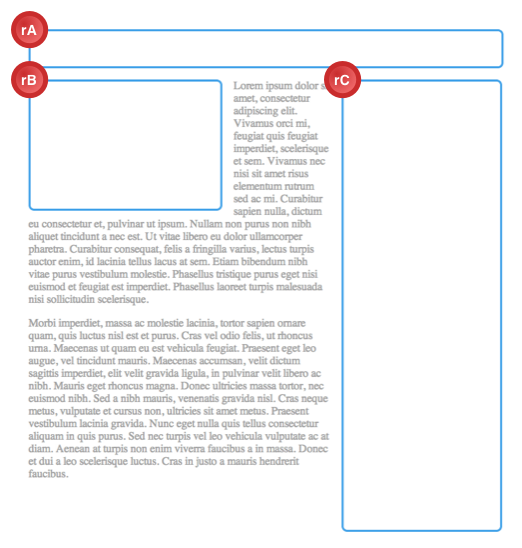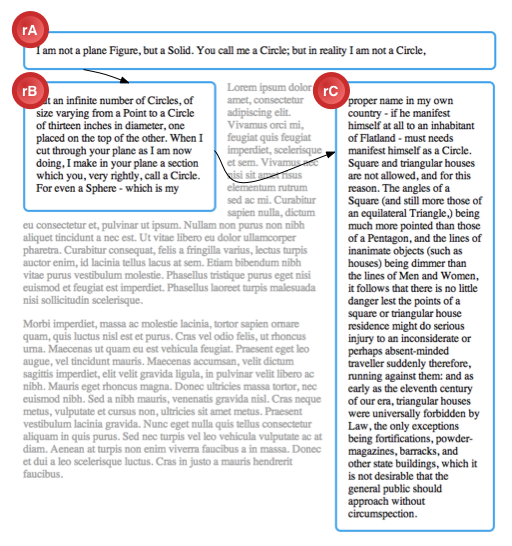
CSS Regions Module Level 3
W3C Working Draft 23 August
2012
- This version:
- http://www.w3.org/TR/2012/WD-css3-regions-20120823/
- Latest version:
- http://www.w3.org/TR/css3-regions/
- Previous version:
- http://www.w3.org/TR/2012/WD-css3-regions-20120503/
- Editors:
- Vincent Hardy, Adobe Systems, Inc., vhardy@adobe.com
- Alex Mogilevsky, Microsoft, alexmog@microsoft.com
- Alan Stearns, Adobe
Systems, Inc., stearns@adobe.com
- Issues List:
- Bugzilla
Bugs for CSS regions
- Discussion:
- www-style@w3.org
with subject line "
[css3-regions] message topic"
Copyright © 2012 W3C® (MIT, ERCIM,
Keio), All Rights Reserved. W3C liability,
trademark
and document
use rules apply.
Abstract
The CSS regions module allows content to flow across multiple areas
called regions. The regions are not necessarily contiguous in the document
order. The CSS regions module provides an advanced content flow mechanism,
which can be combined with positioning schemes as defined by other CSS
modules such as the Multi-Column Module [CSS3COL] or the Grid Layout Module
[CSS3-GRID-LAYOUT] to
position the regions where content flows.
Status of this
document
This section describes the status of this document at the time of
its publication. Other documents may supersede this document. A list of
current W3C publications and the latest revision of this technical report
can be found in the W3C technical reports
index at http://www.w3.org/TR/.
Publication as a Working Draft does not imply endorsement by the W3C
Membership. This is a draft document and may be updated, replaced or
obsoleted by other documents at any time. It is inappropriate to cite this
document as other than work in progress.
The (archived) public
mailing list www-style@w3.org (see
instructions) is preferred
for discussion of this specification. When sending e-mail, please put the
text “css3-regions” in the subject, preferably like this:
“[css3-regions] …summary of comment…”
This document was produced by the CSS Working Group (part of
the Style Activity).
This document was produced by a group operating under the 5 February
2004 W3C Patent Policy. W3C maintains a public list of any patent disclosures made in
connection with the deliverables of the group; that page also includes
instructions for disclosing a patent. An individual who has actual
knowledge of a patent which the individual believes contains Essential
Claim(s) must disclose the information in accordance with section
6 of the W3C Patent Policy.
This draft is related to the drafts about Multi-column Layout [CSS3COL], Grid
Layout [CSS3GRID], Flexible Box Layout [CSS3-FLEXBOX], and Template
Layout [CSS3LAYOUT].
Table of contents
1. Introduction
This section is non-normative.
Displaying the complex layouts of a typical magazine, newspaper, or
textbook on the web requires capabilities beyond those available in
existing CSS modules. Dynamic magazine layout in particular requires
flexibility in placement of boxes for content flows. This is the purpose
of the CSS regions module.
Issue-15733
Should the region specification define a mechanism to
create blocks that can be regions with CSS syntax?
For more complex layouts, content needs to flow from one area of the
page to the next without limitation on the areas' sizes and positions.
These arbitrary areas are the target of specific content flows which this
document calls named flows. Each named flow can be associated with a set of CSS
Regions called a region chain. CSS Regions are based on the rectangular
geometry of the CSS box model. Elements in a named
flow are taken out of the normal visual formatting and rendered in a
chain of CSS Regions.
1.1. Named flows
and region chains
Consider the layout illustrated in figure 1.
The designer's intent is to position an image in box ‘A’ and to flow an article's content from box
‘1’ through boxes ‘2’, ‘3’ and ‘4’. Note that the second box should have two columns,
and the image is not contained in the article. Box ‘4’ should auto-size to render the remainder of the
article content that did not fit in the earlier boxes.
Figure 2 shows an example of the intended visual rendering of the
content.
There is no existing mechanism in CSS to associate the content with
these boxes arranged in this manner so that content flows as intended. The
CSS regions module properties provide that mechanism.
The following example illustrates how the content of an
<article> element becomes a named flow and how boxes marked with ‘region1’, ‘region2’,
‘region3’ and ‘region4’ IDs become CSS Regions that consume the
‘article_flow’ content.
<style>
article {
flow-into: article_flow;
}
#region1, #region2, #region3, #region4 {
flow-from: article_flow;
}
</style>
The ‘article_flow’ value on the ‘flow-into’ property
directs the article element to the ‘article_flow’ named flow.
Setting the ‘flow-from’ property on block containers to
‘article_flow’ makes them CSS Regions and
associates the resulting region chain with the named flow: the flow is ‘poured’ into the region chain.
See Appendix A for sample code using
grid layout that implements this example
Issue-16858
Should creation of regions from elements be
disallowed?
Note
CSS Regions are independent from layout
Any of the CSS layout facilities can be used to create, position and
size boxes that can become CSS Regions. Using a grid layout [CSS3-GRID-LAYOUT] is just
an example. The example could use a flexible box layout [CSS3-FLEXBOX] instead.
The CSS regions specification does not define a layout mechanism and is
meant to integrate with existing and future CSS layout facilities.
CSS Regions do not have to be elements
The CSS regions module is independent of the layout of boxes and the
mechanism used to create them. For simplicity, our example code in Appendix A uses elements to define the
boxes.
While the example uses elements for CSS Regions (since [CSS3-GRID-LAYOUT]
requires elements to create grid items) it is important to note that this
is not required. CSS Regions can be pseudo-elements, such as ‘::before’ and ‘::after’.
The only requirement for an element or pseudo-element to become a CSS
Region is that it needs to be subject to CSS styling to receive the ‘flow-from’ property.
The CSS page template module (see [CSS3-PAGE-TEMPLATE])
proposes another mechanism to create stylable boxes that can become CSS
Regions with the @slot syntax.
1.2. CSS Region names and
styling
Content can be styled depending on the CSS Region it flows into. It is
an extension of pseudo-element styling such as ::first-line which applies a particular style to a
fragment of content. With CSS Region styling, additional selectors may
apply depending on the CSS Region into which content flows.
In our example, the designer wants to make text flowing into #region1
dark blue and bold.
This design can be expressed as shown below.
<style>
@region #region1 {
p {
color: #0C3D5F;
font-weight: bold;
}
</style>
The @region #region1 rule limits its selectors to
content flowing into #region1. The following figure
shows how the rendering changes if we apply styling specific to
#region1. Note how less text fits into this box now that the
‘font-weight’ is bold instead of normal.
2. CSS regions
concepts
2.1. Regions
Issue-15186
Is a mechanism to auto-generate regions necessary in
order to support reusable style sheets?
Issue-15187
Explain how regions and pages interact. How can
regions be placed onto certain pages, and how can they be positiond
wrt. pages.
A CSS Region is a block
container that has an associated named
flow (see the ‘flow-from’ property).
2.2. Region chain
A region chain is the sequence of regions
that are associated with a named flow. CSS Regions in a region chain receive
content from the named flow following their order in the chain. CSS Regions are organized into a region chain according to the document order.
2.3. Named flows
A named flow is the ordered sequence of
elements associated with a flow with a given identifier. Elements in a named flow are ordered according to the document
order.
Elements are placed into a named flow with
the ‘flow-into’
property. The elements in a named flow are laid
out in the region chain that is associated
with this named flow.
Content from a named flow is broken up
between regions according to the regions flow breaking rules.
A named flow is created when at least one
element is moved into the flow with the given identifier or when at least
one CSS Region requests content from that flow.
2.4. Regions
flow breaking rules
Breaking a named flow across a region chain
is similar to breaking a document's content across pages (see [CSS3PAGE]) or a
multi-column element's content across column boxes (see [CSS3COL]). One difference is that
page boxes are generated based on the available content whereas a region
chain is a set of recipient boxes for the named
flow content whose dynamic generation is not in the scope of this
specification.
Each CSS Region in turn consumes content from its associated named flow. The named
flow content is positioned in the current region until a natural or forced region
break occurs, at which point the next region in the region chain becomes the current region. If there
are no more regions in the region chain and
there is still content in the flow, the positioning of the remaining
content is controlled by the ‘region-overflow’ property on the last region in the chain.
The CSS regions module follows the fragmentation rules defined in the
CSS Fragmentation Module Level 3 (see [CSS3-BREAK]).
3. Properties and
rules
3.1. The ‘flow-into’ property
Issue-15811
Creating a named flow from external resource
The ‘flow-into’ property can place an element into a named flow. Elements that belong to the same flow
are laid out in the region chain associated with that flow.
| Name:
| flow-into
|
| Value:
| <ident> | none | inherit
|
| Initial:
| none
|
| Applies to:
| any element.
The ‘flow-into’ property does not apply to any
pseudo-element
such as ::first-line, ::first-letter, ::before or
::after.
|
| Inherited:
| no
|
| Percentages:
| N/A
|
| Media:
| visual
|
| Computed value:
| as specified
|
- none
- The element is not moved to a named flow
and normal CSS processing takes place.
- <ident>
- The element is taken out of its parent's flow and placed into the flow
with the name ‘
<ident>’. The element is
said to have a specified flow. The values
‘none’, ‘inherit’, ‘default’, ‘auto’
and ‘initial’ are invalid flow names.
A named flow needs to be associated with a
region chain (one or more CSS regions) for its elements to be visually
formatted. If no region chain is associated with a given named flow, the elements in the named flow are not rendered: they do not generate
boxes and are not displayed.
The children of an element with a specified flow may themselves have a
specified flow.
If an element has the same specified flow as one of its ancestors, it
becomes a sibling of its ancestor for the purpose of layout in the region
chain laying out content from that flow.
The ‘flow-into’
property does not affect the CSS cascade and inheritance for the elements
on which it is specified. The ‘flow-into’ property affects the visual
formatting of elements placed into a named flow
and of the region chain laying out content from a named flow.
The edges of the first CSS region in a region chain associated with a named flow establish the rectangle that is the containing
block used for absolutely positioned elements in the named flow which do not have an ancestor with a
‘position’ of ‘absolute’, ‘relative’ or ‘fixed’ (see [CSS21]). That first CSS region
rectangle is used as the containing block instead of the initial
containing block. This does not affect fixed position elements in the named flow - they are still positioned relative to
the viewport or page area even if they have been redirected to a named
flow.
The first region defines the writing
mode for the entire flow. The writing mode on subsequent regions is
ignored.
Elements in a named flow are sequenced in
document order.
Note
The ‘flow-into’ property moves an element into the
flow and the interplay with selectors should be considered carefully.
For example,
table {flow-into: table-content}
will move all tables in the ‘table-content’ named
flow. However, the
table > * {flow-into: table-content} ...
selector will move all immediate children of all table elements into
the ‘table-content’ named flow (which may
be useful as it will usually result, if the immediate children are rows,
in merging rows of multiple tables), but the
table * {flow-into: table-content}
selector will move all descendants of table elements into the
‘table-content’ named flow, transforming
the element tree into a flat list in order of opening tags (which is
probably not intentional). This will make all the descendants of table
elements siblings in the named flow. Having
the descendants become siblings in the named
flow results in a different processing (see CSS
2.1‘s anonymous table objects). This note
illustrates how authors must exercise caution when choosing a particular
selector for setting the ’flow-into' property to avoid unintended
results.
3.2. The ‘flow-from’ property
The ‘flow-from’
property makes a block container a region and associates it with a named flow.
| Name:
| flow-from
|
| Value:
| <ident> | none | inherit
|
| Initial:
| none
|
| Applies to:
| Non-replaced block
containers.
This might be expanded in future versions of the specification to allow
other types of containers to receive flow content.
|
| Inherited:
| no
|
| Percentages:
| N/A
|
| Media:
| visual
|
| Computed value:
| as specified
|
- none
- The block container is not a region.
- <ident>
- If the ‘
content’ property computes to
something else than ‘normal’, the block
container does not become a CSS Region. If the ‘content’ property computes to ‘normal’, then the block container becomes a
CSS Region and is ordered in a region chain according to its document order.
The content from the flow with the <ident>
name will be broken into fragments and
visually formatted in the principal
boxes of the regions in the region chain.
If there is no flow with name <ident>, then the block container
does not format any content visually.
Likewise, if the block container is part of the flow with name
<ident>, then the block container does not format any content
visually.
Issue-16819
No display when combining flow-from and flow-into is
bad
A CSS Region‘s document children are not
visually formatted unless they are directed to a named flow with an associated region chain.
Note
An block container becomes a CSS Region when its
’flow-from' property is set to a valid <ident> value, even if
there is no content contributing to the referenced flow. For example:
<style>
.article{
flow-into: thread;
}
.region{
flow-from: thread;
}
</style>
<html>
<body>
<div class=region>div content</div>
</body>
</html>
There is no element matching the
.article selector and
therefore no content in the
thread flow. However, the block
container matching the
.region
selector is still associated with that empty
named
flow and, consequently, its children are not formatted visually.
Note
At the time of this note-writing, the display values that
always result in a non-replaced block container include
block, inline-block, table-cell,
table-caption, and list-item. All of these
display values work as regions with non-replaced elements.
Issue-15824
Should regions not create a new stacking context?
Issue-15827
Specify behavior of stacking contexts that are split
between regions
CSS Regions create a new stacking
context. CSS Regions establish
a new block
formatting Context.
Note
With region chains, an element may be
split across multiple boxes and these boxes may overlap (for example if
they are absolutely positioned). So fragments of the same element can
overlap each other. Since each element has a single z-index, it would be
required to find another mechanism to decide in which order
the fragments are rendered. Since each CSS Region creates a
new stacking context, it is clear that each fragment is rendered
separately and their rendering order follows the regular CSS rendering
model.
Floats or other exclusions (see [CSS3-EXCLUSIONS])
potentially impact the content laid out in region chains, just as for
non-regions.
See the regions visual
formatting details section for a description of how ‘width’ and ‘height’ values are resolved for CSS
Region boxes.
User agents laying out content in multiple regions must determine where
content breaks occur. The problem of breaking content into fragments
fitting in regions is similar to breaking content into pages or columns.
Each break ends layout in the current region and causes remaining pieces
of content from the named flow to be visually
formatted in the following region in the region chain, if there is one.
The following extends the ‘break-before’, ‘break-after’ and ‘break-inside’
properties from the [CSS3COL] specification to account
for regions. The additional values are described below.
| Name:
| break-before
|
| Value:
| auto | always | avoid | left | right | page | column | region |
avoid-page | avoid-column | avoid-region
|
| Initial:
| auto
|
| Applies to:
| block-level elements
|
| Inherited:
| no
|
| Percentages:
| N/A
|
| Media:
| visual
|
| Computed value:
| specified value
|
| Name:
| break-after
|
| Value:
| auto | always | avoid | left | right | page | column | region |
avoid-page | avoid-column | avoid-region
|
| Initial:
| auto
|
| Applies to:
| block-level elements
|
| Inherited:
| no
|
| Percentages:
| N/A
|
| Media:
| visual
|
| Computed value:
| specified value
|
| Name:
| break-inside
|
| Value:
| auto | avoid | avoid-page | avoid-column | avoid-region
|
| Initial:
| auto
|
| Applies to:
| block-level elements
|
| Inherited:
| no
|
| Percentages:
| N/A
|
| Media:
| visual
|
| Computed value:
| specified value
|
These properties describe page, column and region break behavior
before/after/inside the generated box. These values are normatively
defined in [CSS3COL]:
This specification adds the following new values:
- region
- Always force a region break before (after) the generated box.
- avoid-region
- Avoid a region break before (after, inside) the generated box.
The behavior of region breaks with regards to regions is identical to
the behavior of page breaks with regards to pages, as defined in the [CSS21].
3.4. The
region-overflow property
| Name:
| region-overflow
|
| Value:
| auto | break
|
| Initial:
| auto
|
| Applies to:
| CSS Regions
|
| Inherited:
| no
|
| Percentages:
| N/A
|
| Media:
| visual
|
| Computed value:
| specified value
|
Issue-15832
Should we have region-overflow:nobreak and have
region-overflow apply to all regions, not just the last?
Issue-16622
Should we rename region-overflow to flow-overset?
The ‘region-overflow’ property controls the
behavior of the last region associated with a named flow.
- auto
- Content flows as it would in a regular content box. If the content
exceeds the container box, it is subject to the overflow
property's computed value on the CSS Region. Region breaks must be
ignored on the last region.
- break
-
If the content fits within the CSS Region, then this property
has no effect. If the content does not fit within the CSS
Region, the content breaks as if flow was going to continue in a
subsequent region. See the breaking rules section. A forced
region break takes precedence over a natural break point.
Flow content that follows the last break in the last region, if any is
not rendered.
The ‘region-overflow’ property does not influence
the size of the region it applies to.
The following code sample illustrates the usage of the ‘region-overflow’
property.
<style>
article {
flow-into: "article";
}
#region_1, #region_2 {
flow-from: article;
region-overflow: break; /* or auto */
overflow: visible; /* or hidden */
}
</style>
<article>...</article>
<div id="region_1"></div>
<div id="region_2"></div>
Note
The ‘overflow’ property is honored on a
region: if region content overflows, such as the borders of elements on
the last line, the ‘overflow’ property
controls the visibility of the overflowing content. See the ‘overflow’ property definition ([CSS21]).
3.5. The @region
rule
An ‘@region’ rule
contains style declarations specific to particular regions.
@region <selector> {
... CSS styling rules ...
}
The ‘@region’ rule
consists of the keyword ‘@region’ followed by a selector
and a block of style rules. The ‘@region’ rule and the selector constitute the
region's ‘flow fragment’ selector. The region's
flow fragment selector specifies which range of elements in the flow are
subject to the style rules in the following block: it applies to the range
(see [DOM]) from the
region's flow that flows in the selected region(s).
Elements that are fully or partially in the ‘flow
fragment’ may match any of the selectors found in the style rule.
However, the style rules only apply to the portion of the element that
falls into the corresponding region.
Only a limited list of properties can be set in a region style rule:
Issue-16921
Should text-align be added to region styling
properties
- font properties
- color property
- opacity
property
- background
property
- ‘
word-spacing’
- ‘
letter-spacing’
- ‘
text-decoration’
- ‘
text-transform’
- ‘
line-height’
- border
properties
- rounded corner
properties
- border
images properties
- margin
properties
- padding
properties
- ‘
text-shadow’ property
- ‘
box-shadow’ property
- ‘
box-decoration-break’ property
- ‘
width’ property
In the following example, the named flow
‘article_flow’ flows through ‘region_1’ and ‘region_2’.
<style>
#div_1 {
flow-into: article_flow;
}
#region_1, #region_2 {
flow-from: article_flow;
}
/* region style "RSA" */
@region #region_1, #region_2 {
div {...}
p {...}
}
/* region style "RSB" */
@region #region_1 {
p {...}
}
</style>
<div id="div_1">
<p id="p_1">...</p>
<p id="p_2">...</p>
</div>
<div id="region_1"></div>
<div id="region_2"></div>
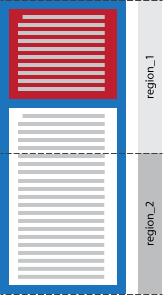
- div div_1
- paragraph p_1
- paragraph p_2
- range of flow
that fits into region_1
- range of flow
that fits into region_2
The region style ‘RSA’ applies to flow
content that is laid out in either ‘region_1’
or ‘region_2’.
The first rule set ‘div {...}’ applies to
all <div> elements that fit partially or
fully into ‘region_1’ or ‘region_2’. div_1 is split
between ‘region_1’ and ‘region_2’ and gets the style from this style rule.
The second rule set ‘p {...}’ applies to all
<p> elements that fit into ‘region_1’ or ‘region_2’. In
our example, both p_1 and p_2 are selected.
The region style ‘RSB’ applies to flow
content that fits in ‘region_1’.
The first rule set ‘p {...}’ matches p_1 and p_2 because these
paragraphs flow into ‘region_1’. Only the
fragment of p_2 that flows into region_1 is styled with this rule.
The specificity of the selectors in a ‘@region’ rule is calculated as defined in the
CSS Selectors module (see [SELECT]). In other words, the ‘@region’ rule adds an
extra condition to the selector's matching, but does not change the
selector's specificity. This is the same behavior as selectors appearing
in ‘@media’ rules declaration blocks (see [MEDIAQ]), where the
rule does not influence the selectors' specificity.
Consequently, selectors that match a given element (as describe above),
participate in the CSS
Cascading order as defined in [CSS21].
Region styling does not apply to nested regions. For example, if a
region ‘A’ receives content from a flow
that contains region ‘B’, the content that
flows into ‘B’ does not receive the region
styling specified for region ‘A’.
4. Multi-column
regions
A multi-column
[CSS3COL] element
can have an assigned named
flow. The element becomes part of the region chain for
that named flow, and flows its content fragments through columns according
to the multi-column specification [CSS3COL]. In particular, when
computing the flow
fragment height of a multi-column element that is associated with a named flow, the ‘column-fill’ [CSS3COL] property is honored to
balance the fragments of content that would flow through its columns.
The following example:
<style>
#multi-col {
column-count: 2;
flow-from: article;
height: 6em;
column-gap: 1em;
}
#remainder {
flow-from: article;
height: auto;
}
</style>
<article>...</article>
<div id="multicol"></div>
<div id="remainder"></div>
is equivalent in rendering to, for example:
<style>
#flex {
display: flex;
flex-pack: justify;
height: 6em;
}
#flex > div {
flow-from: article;
width: calc(50% - 0.5em);
}
#remainder {
flow-from: article;
height: auto;
}
</style>
<article>...</article>
<div id="flex">
<div />
<div />
</div>
<div id="remainder"></div>
Overflow of multicol regions is mostly handled according to the same
rules as other CSS Regions. If the remainder of the named flow does not
fit in the multicol region, then the rest of the content flows into the
remaining region chain. However, if a multicol region is the last region
in a region chain, then the multicol region
must follow the overflow
column rules [CSS3COL].
5. Pseudo-elements
Issue-15188
add functionality for having textual description like
"continued here" or "continued on page x" to regions.
It can be useful to visually mark the content to highlight that a
content thread is flowing through the region chain. For example, a marker
such as ‘continued below’ clearly
indicates, at the end of a CSS Region, that there is more content in the
flow which can be found by scrolling past whatever content interrupts the
region chain.
The ‘::before’ and ‘::after’ pseudo-elements (see [SELECT]) let content authors mark
the beginning and end of a region with such markers.
5.1. Processing model
The ‘::before’ content is laid out in the
region prior to any other content coming from the flow. Note that it is
possible to set the ‘::before’ pseudo-element's
‘display’ property to ‘run-in’ to align it with the content's inline
boxes.
The ‘::after’ content is laid out in the
region after laying out the flow fragment content. Then, flow content is
removed from the fragment to accommodate the ‘::after’ content. Accommodating means that the ‘::after’ content is laid out without overflowing the
region. The ‘display’ property of the
‘::after’ content can be set to ‘run-in’ to align with the region's content's
inline boxes. In that case, the ‘::after’
content becomes the last inline box of the previous element in the flow
that has some visual rendering in the region and can accommodate for the
‘::after’ box.
If there is not enough room to accommodate the ::before content, the
‘::after’ content after removing all flow
fragment content, or a combination of the two, then the ::before and/or
::after content overflows.
6. CSSOM
Issue-15933
Terms in WebIDL snippets inconsistently linked
Since content may flow into multiple regions, authors need a way to
determine if there are enough regions to flow all the content from a named
flow. This is especially important considering that the size of regions or
the size of the content may change depending on the display context. For
example, flowing the same content on a mobile phone with a small screen
may require more regions than on a large desktop display. Another example
is the user changing the font size of text flowing through regions.
Depending on the change, new regions may be needed to accommodate for the
additional space required to fit the larger text or some regions may need
to be removed for smaller text.
6.1. The NamedFlow
interface
A named flow is created when it becomes
referenced by the ‘flow-into’ and/or ‘flow-from’ computed
values. The following APIs allow scripts to reference a NamedFlow object
representation of a named flow.
An additional method on the Document interface provide access to named flows.
partial interface Document {
NamedFlowCollection getNamedFlows();
};
The getNamedFlows() method on the Document interface returns a static snapshot of all
the current named flows in the document.
The namedFlows
collection must include all named flows that
are currently in the CREATED state. The list must not include
named flows that are in the NULL
state.
NULL: the user agent must return
null.
CREATED: the user agent must return a valid NamedFlow instance.
The NamedFlowCollection interface provides a list of
current NamedFlow
instances in the document. The collection is a snapshot of the data.
interface NamedFlowCollection {
readonly attribute unsigned long length;
[IndexGetter] NamedFlow? item (unsigned long index);
[NameGetter] NamedFlow? namedItem (DOMString name);
};
The length attribute returns the number of items in the
collection.
The item(index) method returns the NamedFlow instance at index
index in the collection or null if
index is out of range. An object collection
implementing NamedFlowCollection
supports indices in the range 0 ≤ index <
collection.length.
The namedItem(name) method returns the NamedFlow instance in the
collection whose name attribute matches the supplied name, or null if there is no match.
The NamedFlow
interface offers a representation of a named
flow instance.
The NamedFlow
interface can be used for different purposes. For example, the getRegionsByContent()
method can help navigate by bookmark: a script can find the regions that display a particular anchor and bring
them to view.
Likewise, the interface allows authors to check if all content has been
fitted into existing regions. If it has, the overset attribute would be
false.
interface NamedFlow : EventTarget {
readonly attribute DOMString name;
readonly attribute boolean overset;
sequence<Region> getRegions();
readonly attribute integer firstEmptyRegionIndex;
NodeList getContent();
sequence<Region> getRegionsByContent(Node node);
};
The name
attribute returns the name of the NamedFlow instance.
The overset
attribute returns true if there are named flow
fragments that do not fit in the associated region chain. The attribute
also returns true if there is no associated region chain. Otherwise, it
returns false.
The getRegions() method returns the sequence of regions
in the region chain associated with the named flow. Note that the returned values is a
static sequence in document order.
The firstEmptyRegionIndex is
the index of the first region in the region chain with the regionOverset attribute
set to empty. If all regions have the regionOverset attribute
set to fit or overset, the value for firstEmptyRegionIndex
is -1. If there are no regions in the region chain, the value is -1 as
well.
The getContent() method returns
an ordered collection of nodes that constitute the named flow. The returned list is a static snapshot
of the named flow content at the time the
method is invoked. This list contains the elements that were moved to the
named flow by their flow-into property but not
their descendants (unless the descendants are themselves moved to the named flow).
The getRegionsByContent()
method returns the sequence of regions that contain at least part of the
target content node if it belongs to the named
flow directly (i.e., its ‘flow-into’ computed value is the named flow) or one of its ancestors belongs to the
named flow. Otherwise, the method returns an
empty sequence. The returned value is a static sequence in document order.
The named flow states are :
A NamedFlow object
is live: it always represents the named flow
with the corresponding name even if that named
flow has transitioned to the NULL state.
If a script holds a reference to a NamedFlow instance that has entered the
NULL state, its attributes and methods should behave as
follows:
Issue-16382
Should we have a NamedFlow.getRegionsByFlowRanges?
6.2. The Region
interface
The Region
interface is a supplemental
interface which must be implemented by all objects ( Elements, pseudo-elements or other CSS constructs
such as slots)
in an implementation which can be CSS Regions.
[NoInterfaceObject]
interface Region {
readonly attribute DOMString regionOverset;
sequence<Range>? getRegionFlowRanges();
CSSStyleDeclaration getComputedRegionStyle(Element elt);
CSSStyleDeclaration getComputedRegionStyle(Element elt, DOMString pseudoElt);
};
Element implements Region;
The regionOverset attribute returns one of the
following values:
- ‘
overset’
- The region is the last one in the region
chain and not able to fit the remaining content from the named flow. Note that the region's
overflow property value can be used to control the
visibility of the overflowing content and the ‘region-overflow’ property controls whether or
not fragmentation happens on the content that overflows the last region.
- ‘
fit’
- The region's flow fragment content fits into the region's content
box. If the region is the last one in the region chain, it means that the content fits
without overflowing. If the region is not the last one in the region
chain, that means the named flow content is
further fitted in subsequent regions. In this last case, note that the named flow fragment may be empty (for example if
the region is too small to accommodate any content). This value is
returned if the region object is not (or no
longer) a region.
- ‘
empty’
- All content from the named flow was fitted
in prior regions.
Note that if there is no content in the named
flow, all regions associated with that named
flow should have their regionOverset attribute return ‘empty’. If there is content in the flow but that
content does not generate any box for visual formatting, the ‘overset’
attribute on the first region in the region chain associated with the flow
will return ‘fit’.
The getRegionFlowRanges
method returns an array of Range instances
corresponding to fragment from the named flow
that is laid out in the region. If the region has not received a fragment
because it is too small to accommodate any, the method returns a single
Range where the startContainer and
startOffset have the same values as the
endContainer and endOffset and therefore the
collapsed attribute on the Range is true. In that
situation, if the region is the first in the region chain, the startContainer is
the first Node in the named flow
and the startOffset is zero. If the region is the last region
in the region chain (but not the first and only one), the
startContainer and startOffset are the same
values as the endContainer and endOffset on the
previous region in the region chain. The
method returns null if the region object is not
(or no longer) a region.
The getComputedRegionStyle methods
on the Region interface work the same as the getComputedStyle [CSSOM] methods on the Window interface [HTML5] with the following
exceptions. For the Region interface the CSSStyleDeclaration
returned must include the result of region styling. If the element is
fragmented across region boundaries, the CSSStyleDeclaration
returned must apply only to the fragment that flows through the CSS
Region. The method returns null if the region object is not (or no longer) a region.
If the element is not contained in the CSS Region at all,
the method returns the region
styling that would apply to the element if it were contained in the
CSS Region (following how getComputedStyle works with elements not contained
in the window's document).
A Region instance may
represent an object that is no longer a region.
This may happen for example if the ‘flow-from’ property on the corresponding
pseudo-element, element or other construct becomes ‘none’ but a script is still holding a reference to
the Region object.
6.3. The
CSSRegionStyleRule interface
The CSSRegionStyleRule interface represents an ‘@region’ rule in a CSS
style sheet. This rule type is added to the CSSRule
[CSSOM] interface.
partial interface CSSRule {
const unsigned short REGION_STYLE_RULE = 16;
};
- REGION_STYLE_RULE
- The rule is a CSSRegionStyleRule
interface CSSRegionStyleRule : CSSRule {
attribute DOMString selectorText;
readonly attribute CSSRuleList cssRules;
unsigned long insertRule(DOMString rule, unsigned long index)
raises(DOMException);
void deleteRule(unsigned long index)
raises(DOMException);
};
The selectorText attribute gets and sets the associated
selector as defined in section 6.4.3
of [CSSOM].
The cssRules attribute must return a CSSRuleList
[CSSOM] object for
the list of CSSStyleRules specified in the region style block.
The insertRule(rule, index) method inserts a CSSStyleRule into the region style block before the
specified index. If the index is equal to the length of the CSSRuleList
the CSSStyleRule is inserted at the end of the list.
Possible exceptions:
The deleteRule(index) method deletes the CSSStyleRule in the CSSRuleList
at the specified index.
Possible exception:
INDEX_SIZE_ERR: Raised if the specified index does
not correspond to a rule in the region style block.
6.4. Region flow
layout events
NamedFlow objects
are EventTargets
which dispatch regionLayoutUpdate events when there
is a possible layout change in their region chain. Note that the event is
asynchronous.
If region chain nesting occurs (the contents of a NamedFlow contains
regions for a different NamedFlow) then the regionLayoutUpdate event for the nested flow(s) must be
dispatched before the regionLayoutUpdate event for
the containing flow is dispatched.
The remaining issue in this bug is when the event gets
fired.
6.5. Clarifications
on pre-existing APIs
6.5.1. getClientRects() and
getBoundingClientRects()
The CSSOM View Module
defines how user agents compute the bounding client rectangle for an
element (getBoundingClientRect()) and its generated
boxes (getClientRects()).
This definition applies to the (possibly) multiple boxes generated for
an element in a named flow flowing through a region chain. The getClientRects() method returns the list of boxes
generated for each of the element fragments laid out in different regions.
The getBoundingClientRect() method operates as specified in
the CSSOM View Module as
well and is computed from the set of rectangles returned by getClientRects().
6.5.2. offsetTop, offsetLeft, offsetWidth and offsetWidth
The computation of the offset
attributes for elements laid out in a named
flow follow the specification
[CSSOM]. For the
purpose of the algorithm, the first CSS layout box associated
with an element laid out in a named flow is the
box generated for the first region the element is laid out into.
Regions are laid out by CSS and take part in the normal box model and
other layout models offered by CSS modules such as flexible boxes ([CSS3-FLEXBOX]). However, regions lay out a fragment of their named flow instead of laying out descendant
content as happens with other boxes.
This section describes the model for laying out regions and for laying out named flow content into regions. The descriptions
in this section are biased towards a horizontal writing mode, using
width for logical width (or measure) and height
for logical height (or extent) as defined
in the CSS Writing Modes Module [CSS3-WRITING-MODES]).
To use this model in a vertical writing mode apply the principles described
in that specification.
7.1. The Region
Flow Content Box (RFBC)
A region box lays out the following boxes:
- The boxes generated by its
::before and ::after pseudo-elements, if any.
- The anonymous region flow content
box (called RFCB in this document) which
contains the fragment of the named flow that
the region receives.
Laying out a region box follows the same
processing rules as for any other block container
box.
The RFCB is a block container
box with a computed ‘width’ of ‘auto’
and a whose used ‘height’
is resolved as detailed below.
7.1.1. RFCB ‘width’ resolution
At various points in the visual formatting of documents containing
regions, the used ‘width’ of RFCBs and
regions need to be resolved. In all cases, the resolution is done
following the rules for calculating
widths and margins (see [CSS21]). Sometimes, resolving the
used ‘width’ value requires measuring the
content's min-content and max-content values (as defined
in the CSS Writing Modes Module [CSS3-WRITING-MODES]).
For an RFCB, these measures are made on the entire
associated named flow content.
As a consequence, all RFCBs of regions associated with a given named flow share the same min-content and max-content
measures.
This approach is consistent with the box model for
breaking ([CSS3-BREAK]).
Formatting documents that contain named flows
laid out in regions is a three-step process:
- Step 1: RFCB flow fragment
height resolution. In this step, the heights of fragments
fitting in the regions' RFCBs are resolved.
- Step 2: document and regions layout. In this step, the
document content and regions are laid out. However, named flow content is not laid out in regions
yet.
- Step 3: named flow layout. In this
step, the content of named flows is laid out
in their respective region chains.
7.2.1.
Step 1: RFCB flow fragment height resolution
Conceptually, resolving the flow fragment height is a two phase process.
7.2.1.1. RFCB flow fragment height resolution, Phase 1
The document is laid out with a used height
of zero for all RFCBs. In this phase, the content of
named flows is not laid out in regions. This phase yields resolved position and
sizes for all regions and their RFCBs in the document.
7.2.1.2. RFCB flow fragment height resolution, Phase 2
Named flows are laid out in regions. The user agent resolves the flow fragment
height for the RFCBs using the
remainder of the flow and accounting for fragmentation rules. This
process accounts for constraints such as the ‘height’ or ‘max-height’ values, as described in the CSS 2.1
section on calculating
heights and margins (see the Block-level
non-replaced elements in normal flow when ‘overflow’ computes to ‘visible’ section and the complicated
cases section). During this phase, generated content is laid out
according to the rules described earlier
in this document.
7.2.2. Step 2: region
boxes layout
In this step, the document is laid out according to the normal CSS
layout rules.
If a measure of the content is required to resolve the used ‘width’ of the region box, the value is resolved as
described in the RFCB width
resolution section.
If a measure of the content is required to resolve the used height of
the RFCB (for example if the region box is absolutely positioned), the flow fragment height resolved in Step 1
is used for the vertical content measure of the RFCB.
At the end of this step, regions are laid out and ready to receive
content from their associated named flows.
7.2.3. Step 3: named
flows layout
In this final step, the content of named
flows is laid out in the regions‘ RFCBs along with the generated content boxes.
The used ’width' for RFCBs is resolved as described before.
The used ‘height’ of RFCBs is resolved
such that none of the boxes in the region box's normal flow overflow the
region's box. In other words, the RFCB boxes are stretched vertically to
accommodate as much of the flow as possible without overflowing the region
box and accounting for fragmentation rules and
generated content boxes.
During this phase, generated content is laid out according to the rules described earlier in this document.
The model for resolving auto sized regions will cause, under certain
circumstances, the flow content to be overset or underset. In other
words, it will not fit tightly. The model prevents having circular
dependencies in the layout model. Implementations may decide to apply
further layout steps to ensure that the whole flow content is displayed
to the user, even in edge cases.
The process for resolving an RFCB's ‘height’ and the three-step process used to lay out
documents containing regions and named flows
are conceptual descriptions of what the layout should yield and
implementations should optimize to reduce the number of steps and phases
necessary wherever possible.
This section is non-normative.
This example considers a document where content flows between three
regions, and region boxes are intermixed with the normal document content.
<style>
article {
flow-into: article;
}
#rA, #rB, #rC {
flow-from: article;
height: auto;
margin: 1em 1em 0em 1em;
padding: 1em;
border: 3px solid #46A4E9;
}
#rA {
width: auto;
height: auto;
}
#rB {
float: left;
width: 15em;
height: auto;
max-height: 150px;
}
#rC {
float: right;
width: 12em;
height: auto;
}
#main-flow {
padding: 0em 1em 0em 1em;
}
</style>
<body>
<article>
<p style="break-after:region;">I am not a ... </p>
<p>...</p>
</article>
<div id="rA"></div>
<div id="rB"></div>
<div id="rC"></div>
<div id="main-flow">
<p>Lorem ipsum dolor ...</p>
</div>
</body>
The following sections and figures illustrate the intermediate results
for the visual formatting process. In the following, we call RFCB-A,
RFCB-B and RFCB-C the RFCBs for regions rA, rB and rC
respectively.
7.4.1.
Step 1 - Phase 1: Laying out RFCBs with used height of zero
Applying the rules for Step 1, Phase 1, the computed ‘auto’ ‘width’
values for the RFCBs are resolved to used values according to the normal
CSS
layout rules meaning they stretch to the width of their containing
block's content box.
- RFCB-A: stretches to fit the rA content box.
Since rA also has an ‘auto’ ‘width’, its own used ‘width’ is stretched to fit the
<body> content box.
- RFCB-B: stretches to fit the
rB content box.
- RFCB-C: stretches to fit the
rC content box.
Also applying the rules for Step 1, Phase 1, the used values for the
RFCBs ‘height’ properties are all zero.
Conceptually, this produces the layout illustrated below.
7.4.2.
Step 1 - Phase 2: Layout flow to compute the RFCBs' flow fragments
heights
In this second phase of Step 1, the named flow is laid out in regions and the height of each fragment falling in
each RFCB is computed.
The user agent lays out as much of the flow into an area with RFCB-A's
used ‘width’. rA's ‘height’ computes to ‘auto’ and there is no vertical maximum height for
RFCA's ‘height’. However, because there is
a break after the first paragraph in the ‘article’ named
flow, only this first paragraph is laid out in RFCB-A and FH-A
(the flow fragment height for RFCB-A) is resolved by laying out this first
paragraph in the used ‘width’.
At this point, the user agent lays out as much of the remaining flow as
possible in RFCB-B. Because rB's ‘max-height’ computed value is ‘150px’, the user agent only lays out the ‘article’ named flow using RFCB-B's used ‘width’ until the point where laying out additional
content would cause RFCB-B to overflow rB's box. The fragment height for
RFCB-B is resolved: FH-B (150px).
Finally, the user agent lays out the remainder of the flow in RFCB-C.
Because rC has no other constraints and no region breaks, the remaining
content is laid out in RFCB-C's used ‘width’. This results in a resolved flow fragment
height: FH-C.
7.4.3.
Step 2: Layout document and regions without named flows
The used ‘width’ of RFCB-A, RFCB-B and
RFCB-C are resolved as in the previous step. However, the ‘height’ is resolved differently.
Resolving the ‘height’ of rA requires a
content measure which is FH-A (the flow fragment height for RFCB-A).
The ‘height’ of rB results from first
computing its content
measure and then applying the rules for
‘max-height’. Here, the vertical
content measure evaluates to FH-B. After applying the rules for ‘max-height’ and accounting for margins, padding
and borders, the used ‘height’ of rB is
resolved to LH-B (150px).
The ‘height’ of rC's box results from calculating
its content measure: FH-C becomes rC's used ‘height’.
7.4.4. Step 3:
named flows layout
In this final step, the article named flow is laid out in its region chain. The used ‘width’ for each of the RFCB is resolved as in step
1 above.
The used ‘height’ for the RFCB is a
result of laying out the as much of the content in the region without overflowing its content box and
following the fragmentation
rules.
Because the computed ‘width’ of the RFCB
has not changed and the fragmentation rules applied are the same as in
Phase 1, Step 2, the used ‘height’ for
RFCB-A, RFCB-B and RFCB-C are LH-A, LH-B and LH-C, respectively.
There may be situations where the used ‘height’ of RFCBs resolved in Step 3 are different
from the flow fragment height computed
in Step 1 Phase 2.
8. Relation to
document events
The CSS regions module does not alter the normal processing of events in
the document tree. In particular, if an event occurs on an element that is
part of a named flow, the event's bubble and capture
phases happen following the document tree order.
9.
Relation to other specifications
This specification is related to other specifications as described in
the references section. In addition, it is
related to the following specifications:
- CSS Fragmentation Module Level 3 [CSS3-BREAK]. This module
defines the rules for fragmenting content over multiple containers and
applies to CSS regions in addition to applying to multi-column and paged
media.
- CSS Pagination Templates Module Level 3 [CSS3-PAGE-TEMPLATE].
This module defines a syntax to define layout templates which can be used
when paginating content. The page templates use regions.
- CSS Exclusions Module [CSS3-EXCLUSIONS]. This
module defines a generic way to define arbitrarily shaped exclusions into
which content can flow or around which content can flow. This can be seen
as an extension to the way CSS floats provide rectangular areas into
which content flows and around which content flows. In advanced layout
designs, it is expected that the CSS Exclusions module will be commonly
combined with the CSS regions module.
- CSS Line Grid Module [CSS3-LINE-GRID]. This
module defines a concept of line grid to align the position of lines in
different elements. The line grid functionality is related and needed for
aligning content flowing in separate regions.
10. Use Cases
Use cases are described on this
page.
12. Changes
12.1. Changes
from May
3rd 2012 version
- Removed exceptions from the Region interface
- Changed NamedFlowCollection from live to a static snapshot
- Changed NamedFlow to inherit from EventTarget
- Removed flowFrom from Region interface and changed method name to
getComputedRegionStyle().
- Region interface is now a supplemental interface with the
[NoInterfaceObject] extended attribute.
- Added note for regionLayoutUpdate dispatching in nested flows.
- Removed Document.getFlowByName() in favor of
NamedFlowCollection.namedItem().
- Changed to overset:false for NULL NamedFlow.
- Changed regionLayoutUpdate to not bubble.
- Modified region styling examples to use element selector instead of of
pseudo-code selectors (this had been omitted in the previous pass at
removing pseudo-code from the examples).
- Removed divs with class set to "issue moved", "issue stale" and "issue
resolved" since these divs where not displayed.
- Minor updates to the alternate stylesheet.
- Removed "This section is normative" paragraphs since in CSS
specifications, sections are normative unless otherwise specified.
- Removed "This section is informative" paragraphs since in CSS
specifications notes are always informative.
- Reworded the text about flow-into: <ident> and removed obsolete
text about the interaction with the ‘
content’ property.
- Removed "this section is non-normative" from the "Regions Concepts"
section.
- In the section on region breaks, removed descriptions of break values
normatively defined in external specifications. Removed the section about
split boxes and replaced with paragraph referencing the page breaking
behavior. Removed the discussion about how the ‘
overflow’ property applies to content flown in
regions from the break section, since this is covered in the section on
‘region-overflow’ already. See mailing
list feedback.
- Clarified that @region style rules only apply to the ‘
portion’ of an element that falls into the
corresponding region and added an issue that the model for ‘partial’ styling needs to be defined. See mailing
list feedback.
- Clarified that the
NodeList returned by
getRegionsByContentNode is live.
- Added a name property to the
NamedFlow interface. Added a NamedFlowCollection
interface and added a getNamedFlows method on
the Document interface, as per Bug
15828.
- Modified wording about containing block resolution for absolutely
positioned elements in a named flow.
- Modified initial examples as per Bug 15131
- Multiple editorial changes following mailing
list review comments
- Fixed DOM references to now point to the DOM TR
- Fixed Web IDL issues as reported in Issue
15931
- Added text to explain support for multi-column elements as required by
Issue
15191 and Action 375.
- Renamed ‘
regionOverflow’ to ‘regionOverset’ to avoid confusion between
fitting a flow in regions and the concept of visual overflow that the
word ‘overflow’ (and the property) carry.
- Reworked the partial document interface following the Issue
14948 on
getFlowByName.
- Updated the object model section as proposed on the wiki and in
particular:
- introduced a
Region interface
to replace the supplemental Element interface
- Added a ‘
flowFrom’ attribute on the
Region interface
- NamedFlow.getRegions() was added
- Renamed getContentNode to getContent and getRegionsByContentNode to
getRegionsByContent as per Isseu
15879
- NamedFlow now returns static lists (see Issue
16286)
- Modified region layout event to be dispatched on
NamedFlow instead of region as
before. Was requested by Issue
15938 and required in the general effort to have the DOM APIs work
with non-element regions.
- Changed paragraph on pseudo-elements to disallow ‘
flow-into’ on all
pseudo-elements because moving a ‘::before’
element (for a example) to a named flow does not seem useful and causes
specification and implementation complexity.
- Added section about getClientRects(), getBoundingClientRect(),
offsetWidth, offsetHeight, offsetTop and offsetLeft.
- Added ‘
Regions visual formatting details’
section to better describe the model for resolving auto sizing on
regions.
- Reworked the initial specification example.
- Changed break and region-overflow properties to apply to visual media
instead of paged.
- Added opacity to region styling.
- Added possibility of ::before content contributing to overflow.
- Added CSSRegionStyleRule
- Editorial changes (typos, rephrasings).
- Made ‘
content-order’ a <integer>
and not a <float> following a working group resolution
- Added Alex Mogilevsky as an editor
- Flow names became <ident> instead of <string> following a
working group resolution
- Removed issue about possibly altering the DOM Events model for region
events following a working group resolution
- Made the "relation to document events" section informative following a
working group resolution
- Removed issue in section "The NamedFlow interface" following the
working group's resolution
to have both NamedFlow and the Element interface extension
- Following a working group resolution:
- Turned the first issue in the "Extensions to the Element interface"
into a note explaining that the NamedFlow interface can be used when
regions are pseudo-elements.
- Added NamedFlowUpdate
- Excluded ‘
none’, ‘inherit’ and ‘initial’ from the possible identifier names on
the flow property following discussion
on the mailing list.
- Simplified integration discussion on multi-column layout and just
state that since column boxes are not addressable by selectors, they
cannot be regions.
- Added specification of how the ‘
flow-into’ property interacts with object,
embed and iframe elements.
- Excluded ‘
default’ from the possible
identifier names on the flow property because it may
get reserved.
- Added to the definition of ‘
auto’ on
‘region-overflow’ specifying that region
breaks must be ignored.
- Renamed ‘
Document.flowWithName’ to ‘Document.getFlowByName’ since it is not a property.
- Added a note that a ‘
NamedFlow’ instance is live.
- Added an ‘
undefined’ string value to
the regionOverflow property on the Element interface extension.
- Renamed NamedFlowEvent to regionLayoutUpdate to avoid having ‘
Event’ in the event name.
- Added description for special behavior of iframe/object/embed as flow
source
- Removed issue on copying content to a named flow instead of moving
elements to named flow following working group resolution.
- Removed issue on content:flow-from v.s., flow-from property following
working group resolution.
- Renamed ‘
flow’ to ‘flow-into’ following
working group resolution.
- Updated the css3-grid-align example following working group resolution
that it should use <div> instead of grid-cell pseudo elements that
were removed from the CSS Grid Layout specification.
- Renamed ‘
from-flow’ to ‘flow-from’ following
a working group resolution.
- Limited the applicability of ‘
content:
flow-from()’ to block container box and added a note that this
might be expanded in the future, following a working group resolution.
- Removed issue about API to find which region displays an element in a
named flow since ACTION-350 was
created to add this API.
- In the ‘
flow’ property description,
removed the required wrapper anonymous block as agreed on mailing
list discussion.
- Reworded the paragraph on how regions create a new stacking context,
as per the mailing
list discussion.
- Reworked the "CSS regions Model" section to now be "CSS regions
Layout". Moved the definition of a region as the first sub-section.
- Removed the "Visual Formatting Model and Flows" section to match the
new Regions Model (now CSS regions Layout) section.
- Moved the sections on allowed region breaks, forced region breaks and
"best" regions breaks to follow the property definitions to follow the
formatting of the paged media section in CSS 2.1.
- Added note about why regions create a new stacking context following
the discussion on the mailing
list.
- Removed sentence about content:none making elements disconnected
following the discussion on the mailing
list.
- Removed sentence about content:none making elements disconnected
following the discussion on the mailing
list.
- Added the ::region-before and a ::region-after pseudo-elements.
- Added note of caution when using selectors and the ‘
flow-into’ property
following a mailing
list discussion.
- Removed sections about allowed, forced and best region breaks to align
with the multi-column specification approach and until the group agrees
on where and how the general issue of breaks (regions/pages/columns)
should be addressed.
- Removed the section on Integration with other specifications since
specifications that was superfluous especially since there is no specific
integration with multi column, grid or template layout.
- Added a note that regions establish a new block formatting context.
- Renamed content-order to region-order.
- Added a note about overflowing content in regions (e.g., for content
with borders).
- Added a note that a region cannot layout content it is part of (to
avoid creating a circular dependency) in the flow-from description,
specifying that if flow-from references the flow an element is part of,
then the element does not format anything visually.
- Replaced ‘
content:flow-from(<ident>)’
with ‘flow-from: <ident>’ following a working group
resolution.
- Added more specific wording about auto width and auto height,
following ACTION 351.
- Reworked section on region markers to now use ‘
::before’ and ‘::after’ and
explain how ‘display:run-in’ works with
regions.
- Modified the @region style rule to remove the ::region-lines
pseudo-selector.
- Removed the ‘
region-order’ property
following implementation feedback.
- Specified that region-overflow does not influence a region's size.
- Specified that the flow's writing mode is defined by the first
region's writing mode following mailing
list discussion.
- Made iframe, object and embed support of flow-into optional following
mailing
list discussion.
- Clarified that flow content following the last break in the last
region is not rendered, following mailing
list discussions.
- Modified the rule for computing the width and height of a region when
they are set to auto, following a
mailing list discussion.
- Added ‘
auto’ to the list of invalid
flow identifiers.
- Made ‘
none’ the initial value for
‘flow-into’ and
aligned with ‘flow-from’, as explained in this email.
Also allowed the ‘inherit’ value on ‘flow-from’ and ‘flow-into’ (same
email).
- Added note about nested region styling following a
mailing list discussion.
- Added additional DOM interface following Action 350.
- Clarified that a region becomes a region only if its ‘
content’ property computes to normal, following
the resolution of Issue
22.
- Removed text about special iframe behavior as a result of ACTION 376.
- Made the selectors explicit in the initial section code examples,
following discussion in San Jose, October
2011 face to face meeting.
- Added section on use cases following ACTION-377.
Acknowledgments
The editors are grateful to the CSS working group for their feedback and
help with the genesis of this specification.
In addition, the editors would like to thank the following individuals
for their contributions, either during the conception of CSS regions or
during its development and specification review process:
Rossen Atanassov, Tab Atkins, Mihai Balan, Andrei Bucur, Razvan Caliman,
Alexandru Chiculita, Phil Cupp, Arron Eicholz, John Jansen, Dimitri
Glazkov, Daniel Glazman, Arno Gourdol, David Hyatt, Brian Heuston, Ian
Hickson, Jonathan Hoersch, Michael Jolson, Brad Kemper, Håkon Wium Lie,
Markus Mielke, Robert O'Callahan, Edward O'Connor, Mihnea Ovidenie, Virgil
Palanciuc, Olga Popiv, Christoph Päper, Anton Prowse, Peter Sorotokin,
Christian Stockwell, Eugene Veselov, Boris Zbarsky, Stephen Zilles and the
CSS Working Group members.
Appendix A. Example Code for
Introduction
The following is one possible way to code the example from the introduction. This code uses grid cells to
define, size and position the region areas but table layout, absolute
positioning, or any other CSS layout facility could be used.
<style>
#grid {
width: 80vw;
height: 60vw;
grid-template: "aaa.d"
"....d"
"bbb.d"
"....d"
"ccc.d";
grid-rows: 52% 4% 20% 4% 20%;
grid-columns: 30% 5% 30% 5% 30%;
}
#region1 { grid-cell: a; }
#region2 { grid-cell: b; }
#boxA { grid-cell: c; }
#region3 { grid-cell: d; }
#region4 {
width: 80vw;
}
#region2 {
column-count: 2;
}
/*
* Creates the named flow
*/
article {
flow-into: article_flow;
}
/*
* Associate it with the intended CSS Regions.
* This creates a region chain for the named flow.
*/
#region1, #region2, #region3, #region4 {
flow-from: article_flow;
}
</style>
<!--
The following code element is the content to flow
through the region chain.
-->
<article>
<h1>Introduction</h1>
<p>This is an example ...</p>
<h2>More Details</h2>
<p>This illustrates ...</p>
<p>Then, the example ...</p>
<p>Finally, this ...</p>
</article>
<!--
For this example, we layout the regions with a grid.
Regions could be pseudo-elements and could be laid out
with another layout module (e.g., flexible boxes)
-->
<div id="grid">
<div id="region1"></div>
<div id="region2"></div>
<div id="boxA"></div>
<div id="region3"></div>
</div>
<div id="region4"></div>
Note
Note that a multi-column element is used for #region2, which is a bit
gratuitous here (because grid cells could be used). The reason to use a
multi-column element is to illustrate that regions can be multi-column.
References
Normative references
-
- [CSS21]
- Bert Bos; et al. Cascading Style
Sheets Level 2 Revision 1 (CSS 2.1) Specification. 7 June
2011. W3C Recommendation. URL: http://www.w3.org/TR/2011/REC-CSS2-20110607
- [CSS3-BREAK]
- Rossen Atanassov; Elika J. Etemad. CSS
Fragmentation Module Level 3. 28 February 2012. W3C Working
Draft. (Work in progress.) URL: http://www.w3.org/TR/2012/WD-css3-break-20120228/
- [CSS3-WRITING-MODES]
- Elika J. Etemad; Koji Ishii. CSS
Writing Modes Module Level 3. 1 May 2012. W3C Working Draft.
(Work in progress.) URL: http://www.w3.org/TR/2012/WD-css3-writing-modes-20120501/
- [CSS3COL]
- Håkon Wium Lie. CSS
Multi-column Layout Module. 12 April 2011. W3C Candidate
Recommendation. (Work in progress.) URL: http://www.w3.org/TR/2011/CR-css3-multicol-20110412
- [CSSOM]
- Anne van Kesteren. CSSOM.
12 July 2011. W3C Working Draft. (Work in progress.) URL: http://www.w3.org/TR/2011/WD-cssom-20110712/
- [DOM]
- Anne van Kesteren; Aryeh Gregor; Ms2ger. DOM4.
5 April 2012. W3C Working Draft. (Work in progress.) URL: http://www.w3.org/TR/2012/WD-dom-20120405/
- [DOM-LEVEL-3-EVENTS]
- Travis Leithead; et al. Document
Object Model (DOM) Level 3 Events Specification. 14 June 2012.
W3C Working Draft. (Work in progress.) URL: http://www.w3.org/TR/2012/WD-DOM-Level-3-Events-20120614/
- [HTML5]
- Ian Hickson. HTML5.
25 May 2011. W3C Working Draft. (Work in progress.) URL: http://www.w3.org/TR/2011/WD-html5-20110525/
- [SELECT]
- Tantek Çelik; et al. Selectors
Level 3. 29 September 2011. W3C Recommendation. URL: http://www.w3.org/TR/2011/REC-css3-selectors-20110929/
Other references
-
- [CSS3-EXCLUSIONS]
- Vincent Hardy; Rossen Atanassov; Alan Stearns. CSS
Exclusions and Shapes Module Level 3. 3 May 2012. W3C Working
Draft. (Work in progress.) URL: http://www.w3.org/TR/2012/WD-css3-exclusions-20120503/
- [CSS3-FLEXBOX]
- Tab Atkins Jr.; Elika J. Etemad; Alex Mogilevsky. CSS
Flexible Box Layout Module. 12 June 2012. W3C Working Draft.
(Work in progress.) URL: http://www.w3.org/TR/2012/WD-css3-flexbox-20120612/
- [CSS3-GRID-LAYOUT]
- Alex Mogilevsky; et al. CSS
Grid Layout. 22 March 2012. W3C Working Draft. (Work in
progress.) URL: http://www.w3.org/TR/2012/WD-css3-grid-layout-20120322/
- [CSS3-LINE-GRID]
- Koji Ishii. CSS
Line Grid Module. Proposal for a CSS module. (Retrieved 26
October 2011) URL: http://dev.w3.org/csswg/css-line-grid/
- [CSS3-PAGE-TEMPLATE]
- Alan Stearns. CSS Pagination
Templates Module Level 3. Proposal for a CSS module.
(Retrieved 4 April 2012) URL: http://dev.w3.org/csswg/css3-page-template/
- [CSS3GRID]
- Alex Mogilevsky; Markus Mielke. CSS Grid
Positioning Module Level 3. 5 September 2007. W3C Working
Draft. (Work in progress.) URL: http://www.w3.org/TR/2007/WD-css3-grid-20070905
- [CSS3LAYOUT]
- Bert Bos; César Acebal. CSS
Template Layout Module. 29 April 2010. W3C Working Draft.
(Work in progress.) URL: http://www.w3.org/TR/2010/WD-css3-layout-20100429
- [CSS3PAGE]
- Håkon Wium Lie; Melinda Grant. CSS3 Module:
Paged Media. 10 October 2006. W3C Working Draft. (Work in
progress.) URL: http://www.w3.org/TR/2006/WD-css3-page-20061010
- [MEDIAQ]
- Florian Rivoal. Media
Queries. 19 June 2012. W3C Recommendation. URL: http://www.w3.org/TR/2012/REC-css3-mediaqueries-20120619/
Index
- break-after, 3.3.
- break-before, 3.3.
- break-inside, 3.3.
cssRules, 6.3.
- current-region, 2.4.
deleteRule(index), 6.3.
- firstEmptyRegionIndex, 6.1.
- flow fragment height, 7.2.
- flow-from, 3.2.
- flow-into, 3.1.
- getComputedRegionStyle, 6.2.
- getContent(), 6.1.
getNamedFlows(), 6.1.
- getRegionFlowRanges, 6.2.
getRegions(), 6.1.
- getRegionsByContent(), 6.1.
insertRule(rule, index), 6.3.
item(index), 6.1.
length, 6.1.
name, 6.1.
NamedFlow, 6.1.
- named flow, 2.3.
NamedFlowCollection, 6.1.
namedItem(name), 6.1.
overset,
6.1.
- region, 2.1.
- region chain, 2.2.
- region flow content box, 7.1.
Region interface, 6.2.
- region-overflow, 3.4.
regionOverset, 6.2.
- REGION_STYLE_RULE, 6.3.
- RFCB, 7.1.
selectorText, 6.3.
- specified flow, 3.1.
Property index
